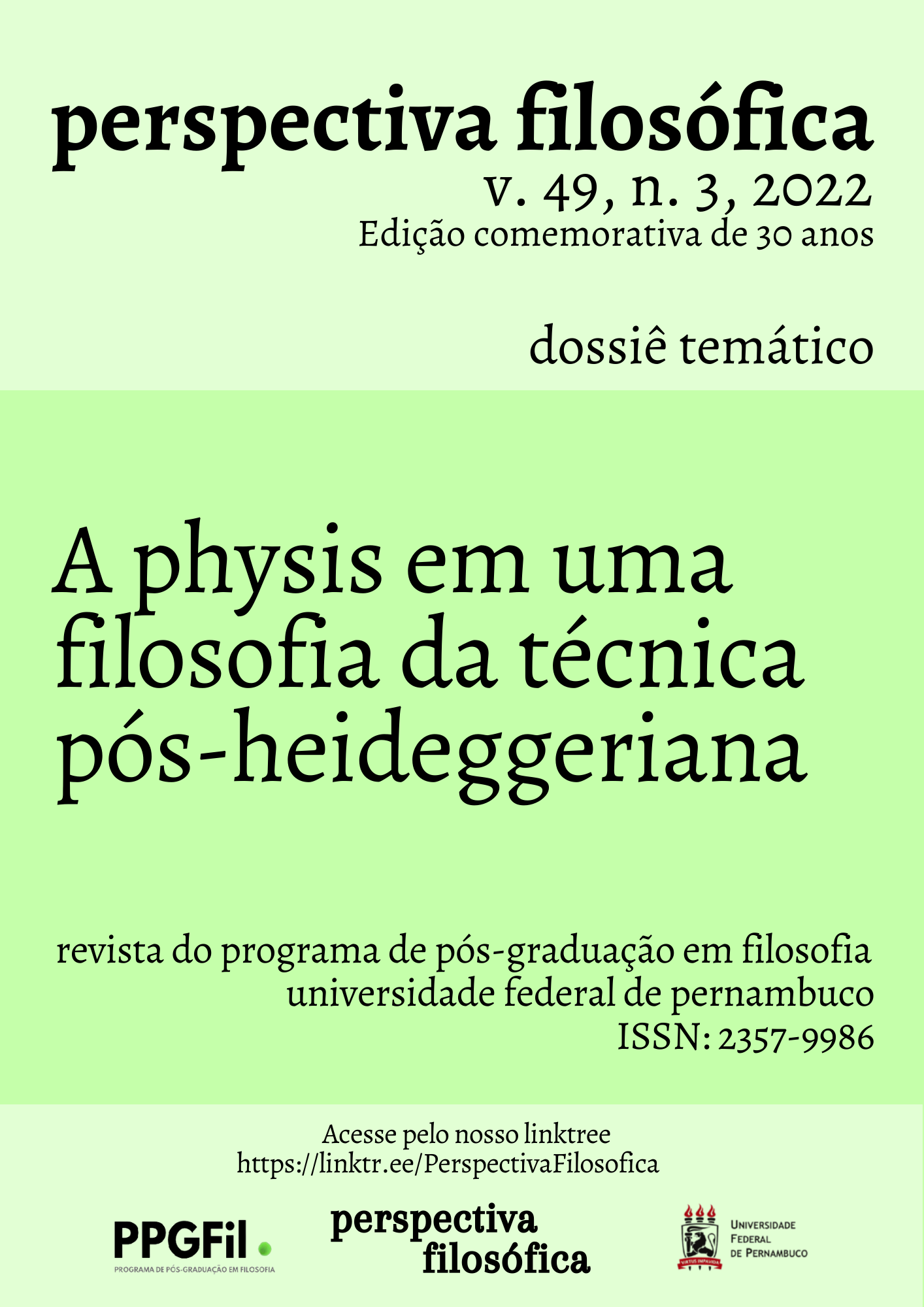De Heidegger à anarquia pantécnica.
DOI:
https://doi.org/10.51359/2357-9986.2022.254746Palavras-chave:
HeideggerResumo
Why after Heidegger (?)
What does it mean to raise the question concerning technology after Heidegger? The average form of the answer could be summed up in one key point: today we must, literally following the way of Heidegger, entrust the question of technology to the matter of thought, by default sharing the belief that this question has no technical solution.Along the way, we must accept the reference point of Heidegger’s thinking, which is a variation of the ontological difference (being is essentially different from a being, from beings) and which is that “the essence of technology is by no means anything technological.”1 This reference point implies the rejection of the instrumental and anthropological definition of technology and is a condition for the release of thought into the open, where only one can get the growth of the saving power (whichwill also, probably, not be anything technical).In other words, to be ‘after Heidegger,’ on average, means to follow his way, moving along it further into the free openness of the ontological relationship (of thought) to technology.However, the extreme form of the answer, to which Heidegger himself pushes us, would suggest something different.He begins manuscripts of the 1940s dealing with modern technology by asking: “[w]hy should the non-intermittent statements of opinion about ‘technology’ be increased by one more?”2 This question marks the task of talking about technology in a way that no one has ever talked about before.It is obvious that today the drama of this question is complicated precisely by the situation that has developed ‘after Heidegger,’ that is, in the conditions when ‘the non-intermittent statements of opinion’ about technologyare produced exactly in the order of following Heidegger’s way.In order to dramatically repeat and put this ‘why,’ today it would be necessary to rather go against Heidegger and talk about technology in a way that no one else, including Heidegger himself, has ever said.
So there are two forms of how to be ‘after Heidegger.’The average form: to be on the side of Heidegger, to speak with his voice, to be possessed by Heidegger3; and the extreme form: to be against Heidegger, to force him to speak with a voice other than his own, to make him possessed. The averaged form opens up a space of safety (there is nothing safer for ‘after Heidegger’ thinking than to rant about the dangers of technology). The extreme form opens up a space in which exactly what Heidegger warned about happened.We will take the way of extreme form.This does not mean that we will not listen to and hear what Heidegger says about technology, it means that we will take what he says to the extreme.Pushing to the extreme is possible in two ways: criticism and anomalous encounters.Critically, we will ask how far Heidegger goes in rejecting anthropologism and instrumentalism, in rejection, on the implementation of which the credibility of his main theses depends.If Heidegger does not bring it to the end, then as a result of a chain reaction, two of his key theses come into question: that the essence of technology is by no means anything technological, and that the question of technology is resolved by means of thought, not technically.Critical pushing to the extreme makes Heidegger flammable and explosive, open to encounters and abnormal rapprochements; criticism releases demonic Heidegger doubles who stand on the other side of the question of technology, putting it from the point of view of technics itself.As anomalous counterparts of Heidegger, we will have the pananarchistGordin Brothers, whose texts, if Heidegger had addressed them, would have forced him to feel them as embodiments of the demonry of technology (which Heidegger, as we know, refused to recognize4).They ask a question similar to Heidegger’s question, but arrive at diametrically opposite conclusions.
Referências
GARCIA, T. Le cercle de la technique // Esprit №3, 2017 (Mars–Avril). P. 133–148.
Gordin Brothers, the. PervyiTsentral’nyiSotsiotekhnicum. Chlenskaiaknizhka [The First Central SocioTechnicum. Membership Book]. Moscow: IzdaniePervogoTsentral’nogoSotsiotekhnikuma, 1919.
HEIDEGGER, M. Hölderlin and the Essence of Poetryin Elucidations of Hölderlins Poetry. Tr. by Keith Hoeller. New York: Humanity Books, 2000. P. 51–66.
HEIDEGGER, M. The Question Concerning TechnologyinThe Question Concerning Technology and Other Essays. Tr. by William Lovitt. New York & London: Garland Publishing, Inc. 1977. P. 3–35.
HEIDEGGER, M. Gesamtausgabe 76.LeitgedankenzurEntstehung der Metaphysik, der neuzeitlichenWissenschaft und der modernenTechnik. Frankfurt am Main: Klostermann Vittorio GmbH, 2009.
KUCHINOV, E. Quesalid’s Knots: A Guide to the Soviet Union’s Esoteric Research Institutes // V – A – C Sreda, 2020, https://sreda.v-a-c.org/en/read-01, accessed April 2021.
LACOUE-LABARTHE, P. Poétique et politiqueinL’Imitation des modernes. (Typographies 2). Paris: Editions Galilée, 1986. P. 175–200.
LARUELLE, F. Le concept d’une «technologie premiere» // Gilbert Simondon. Unepensee de l’individuation et de la technique. Paris: Editions Albin Michel S.A., 1994. P. 206–219.
SCHÜRMANN, R. Heidegger on being and acting. From Principles to Anarchy. Bloomington: Indiana University Press, 1987.
TALLIS, R. A Conversation with Martin Heidegger. London: Palgrave, 2002.
Downloads
Publicado
Edição
Seção
Licença
A Revista Perspectiva Filosófica orienta seus procedimentos de gestão de artigos conforme as diretrizes básicas formuladas pelo Conselho Nacional de Desenvolvimento Científico e Tecnológico (CNPq). http://www.cnpq.br/web/guest/diretrizesAutores que publicam nesta revista concordam com os seguintes termos:
Os autores mantém os direitos autorais e concedem à revista o direito de primeira publicação, sendo o trabalho simultaneamente licenciado sob https://creativecommons.org/licenses/by/4.0/deed.pt_BR que permite o compartilhamento do trabalho com reconhecimento da autoria e publicação inicial nesta revista.
Os autores têm autorização para assumir contratos adicionais separadamente, para distribuição não-exclusiva da versão do trabalho publicada nesta revista, com reconhecimento de autoria e publicação inicial nesta revista (Consultar http://opcit.eprints.org/oacitation-biblio.html).

Esta revista está licenciada com uma Licença Creative Commons Atribuição 4.0 Internacional.













